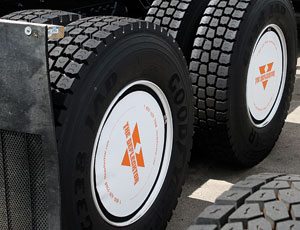A Minnesota entrepreneur’s lightweight, aerodynamic wheel covers promise to save trucking companies millions of dollars in fuel costs every year by boosting big-truck fuel economy by 1%.

Jon Fleck’s “Deflecktor” wheel covers consist of a spring-loaded steel frame that snaps into the standard concave rear wheels of truck tractors. A circular truck-tarp-vinyl cover zips into the frame.
The device cuts drag by keeping air from flowing into and out of the deep rear wheels as the truck speeds along the highway. The covers’ ability to diminish drag boosted fuel economy by 1% during two years of nationwide testing on 1,500 trucks owned by freight-hauling giant Schneider National Inc., Green Bay, Wis. As a result, Schneider is putting the covers on all 12,000 of its tractors.
Although 1% improvement in fuel economy doesn’t sound like much, it will save the firm 1.8 million gal of diesel fuel per year—which is a savings of about 150 gal per truck—according to fuel purchasing manager Bryan Gerl. At today’s pump price of about $3.10 per gallon, the savings would be nearly $5.6 million, or $465 per truck, per year.
Schneider won’t say how much it’s paying for the 48,000 aerodynamic wheel covers, but Gerl says they will pay for themselves in a year or less. The covers, which are expected to last five years, are protected by six patents, and Fleck says six more patents are pending.
The units retail for $50 each on Fleck’s website, www.deflecktor.com, where a demonstration video shows a bare-handed man snapping the spring-steel frame into a wheel and zipping on the vinyl cover in about a minute.
Although the covers may benefit some construction fleets, they might not be for everyone.
“We’ve looked at all kinds of aerodynamic fairings and cab designs, but manufacturers tell us our best bet for improving fuel economy is training drivers to shift efficiently, use the right gears and use other fuel-saving driving techniques,” says Wayne Kokta, transportation manager of Dawes Rigging & Crane Rental Inc., Milwaukee, which operates 50 tractors across the country.
Kokta suggests that using the Deflecktor covers when hauling bulky loads may produce less-than-ideal returns. “The heavy machinery and oversized loads we carry create lots of drag, so cutting a little from the wheels won’t make a big difference,” he explains.
Nevertheless, the potential fuel-economy improvements provided by the wheel covers could play a role in helping heavy-duty trucks meet future work-truck fuel-economy standards, which now are being studied by the federal government.
“Anything that would lower per-mile operating cost is interesting,” says Mike Gibbons, corporate equipment manager for Chicago’s Walsh Group. However, just as with any business, that up-front cost would have to be weighed against potential payback and other factors.


Post a comment to this article
Report Abusive Comment